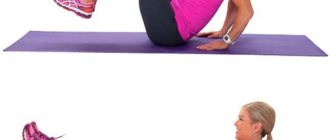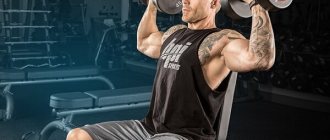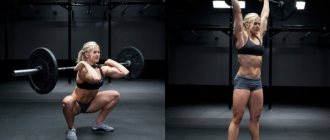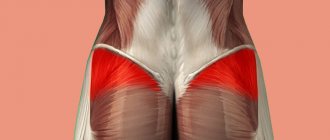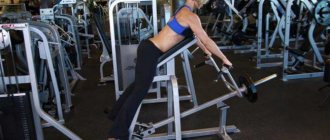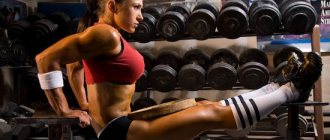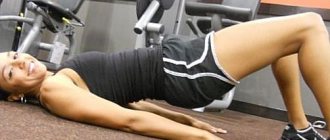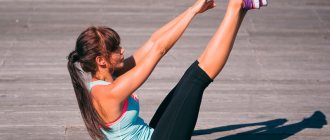In fitness, the lumberjack exercise is one of the most functional and effective movements for the obliques. It is performed in a crossover, but is used extremely rarely in gyms. Mainly due to the fact that the crossover itself is perceived as a trainer for the shoulders, chest and arms, and also because trainers are much more active in driving everyone to the Roman chair. However, incorporating a lumberjack into your program will benefit not only your abs, but other muscle groups as well. In this article we will look at all the technical features and subtleties of the exercise, as well as several types of woodcutter that can be done even at home.
Benefits and disadvantages of exercise
The main benefit of the lumberjack ab exercise is that the movement engages almost all the muscles of the upper body. In terms of muscle fiber recruitment, the woodcutter on the block is superior to almost all other movements for working the abdomen.
Main advantages:
- Working out the oblique and rectus abdominal muscles.
- Improves posture by strengthening your core and upper back muscles.
- Ability to perform movements with heavier weights, accelerating progression.
- Ideal for creating “teeth” in the oblique muscles and increasing their size.
- Develops explosive strength and the ability to quickly contract the abdominal muscles (often used in martial arts).
- Equally effective for both beginners and professional athletes.
The exercise does not have any disadvantages. The only possible disadvantage is the lack of mastery of the technique, in which the main load falls on the arms, which makes the movement less useful for the target area.
Training Recommendations
Whether you want to increase muscle strength or endurance, start doing exercises from 30 seconds to 1 minute
Then, as you get used to it, increase the hold time. It is important to perform all exercises with precise technique, and holding time is not as important as accuracy and feeling the load. To increase strength, try to gradually increase the time of exercise to three minutes. To do this, first tire the muscles with static exercises before dynamic ones.
Or do it as a separate workout. To lose weight and maintain tone, you can alternate static exercises with dynamic ones. For example, do squats, then a plank for a minute, then lunges, and then a plank again.
What muscles work
During the classic movement, the load falls on:
- Oblique abdominal muscles.
- Rectus abdominis muscle.
- Transverse muscle.
- Lower back.
Additional burden falls on:
- Lat.
- Deltas.
- Triceps.
- Back extensors.
Common mistakes
The mistake that athletes make when performing the woodcutter exercise is often bending their arms at the elbow joints, so the entire load goes not on the body, but on the arms.
The second mistake athletes make is arching their back. During training, all the strength goes to the spine. This leads to sprains and serious injuries.
If you liked the exercise called woodcutter, be sure to try it. In order to perform it in strict accordance with the technique and requirements (the result depends on this), start training with a personal trainer.
Lumberjack exercise on a block
A woodcutter in a crossover is the simplest and most convenient option for any gym. With this option, the load falls evenly on all muscles, and it is also possible to minimize the involvement of the hands in the work.
Technique:
- Attach a rope or D-handle to the top pulley.
- Stand with your side to the machine and grab the handle with both hands. The back is straight, feet shoulder-width apart.
- Begin with a powerful movement to lower the handle diagonally towards your knee or thigh (depending on the length of your arms). Rotate your body using your oblique muscles. To lower the weight lower, a slight tilt of the body is allowed with a straight back.
- Take a minimal pause and at a slower pace return the handle to the starting position.
It is important to understand that the main movement is carried out by the body and core muscles.
Beginners should learn to relax their arms and shoulders as much as possible so that they do not “pull” the main load onto themselves.
Safety rules when performing
The lumberjack exercise requires a certain technique. Let's look at a few recommendations for safe execution:
- for beginners, you should start training with minimal weight;
- since the back muscles are involved in the exercise, increase the load gradually;
- do not make sudden movements, this can lead to damage to the shoulder joints and vertebrae;
- Before each workout, you should do exercises to warm up your muscles so as not to get a sprain or injury to your back;
- the feet should be fixed as much as possible and should not come off the surface when performing;
- keep your back straight, don’t lower your head;
- watch your breathing, do not allow yourself to hold your inhalations or exhalations;
- The body should not turn much when raising your arms up.
Reverse lumberjack exercise
Unlike the classic version, the reverse lumberjack emphasizes the upper obliques, deltoids, and lats.
Technique:
- Attach the handle to the lower block and hold it with both hands. Bend down slightly (with a straight back).
- With a powerful jerking movement, move the weight from the bottom position to the top position diagonally. At the same time straighten your back.
- At a slower pace, return the handle to the starting position.
As with the upper block, it is important to feel the load even in the starting position. To do this, you should move half a step away from the machine to ensure tension on the cable.
Varieties
We analyzed the classical technique in detail. Now let's look at other implementation options.
"Lumberjack" with a weight
The exercise can be done with a dumbbell or exercise ball. Technique:
- Stand straight with your feet slightly wider than shoulder-width apart.
- Grasp the handle of the kettlebell with both palms and lower it in front of you.
- Inhale, twist your body to the right.
- At the same time, bend your legs and bend slightly until the projectile touches the floor.
- Exhale, rise up and rotate your body 180°, lifting the kettlebell above your head.
"Lumberjack" with a barbell
Technique:
- Remove the bar from the racks and place one end of it in a corner.
- Throw pancakes on the other end.
- Raise the loaded edge to chest level.
- Place your feet wider than shoulder-width apart.
- Exhale and twist your body to the right.
- At the same time, lower the edge of the bar to your right knee and turn your left foot inward.
- As you inhale, rise to the starting position and repeat on the other side.
https://www.youtube.com/watch?v=tOwU2ZNVLlY
Reverse "lumberjack"
The element is performed in a crossover:
- Attach a rope handle to the cable of the lower block and grab it.
- Step back about a meter and turn sideways.
- Keep your hands near your hips, keeping the cable taut and the load slightly elevated.
- Exhale and pull the handle diagonally upward.
- At the same time, turn your body sideways.
- At the top point, freeze for a second, then inhale and return to the starting position.
When doing this, do not bend your elbows and keep your abs tense.
"Lumberjack" on his knees
Thanks to this technique, the leg muscles are excluded from the work, the emphasis shifts to the abdominals:
- Grip the D-handle attached to the top cable of the pulley machine with both hands.
- Step back a meter, turn sideways and kneel down.
- Exhale and twist your body to the side, while simultaneously moving the handle diagonally down.
- As you exhale, return to the starting position.
If it is difficult to maintain balance while kneeling, put your leg forward (the one closest to the machine) and bend it at a right angle. This version of the exercise is called the “lumberjack lunge.”
The considered elements should be done for 3-4 sets of 12-15 repetitions. If your goal is weight loss, increase the number of movements to 20 in each set and increase the intensity of the exercise.
Lumberjack exercise with dumbbells
A woodcutter with a dumbbell is considered a rather inconvenient option, although once you master the technique it can become a worthy replacement for other versions. Unlike a crossover, it puts more stress on the arms and shoulders (which are forced to make an effort to lift the weight or prevent it from falling). Refers to the reverse type.
Technique:
- Hold a dumbbell in both hands and stand straight with your feet shoulder-width apart. Hold the projectile at knee level with your body slightly tilted forward.
- With a quick movement, move the dumbbell in an arc to the level of the opposite shoulder (from the left knee to the right shoulder and vice versa).
- Without pausing, return the dumbbell to the starting position.
It is important to avoid “throwing” the weight down by inertia; this is a key point for correct execution.
You should also be careful not to hit your knee with the dumbbell when lowering the apparatus.
Training plan
Let's do something radical: no division of the body into biceps and triceps, only general training, basic exercises. The only equipment you will need is one barbell, a pair of dumbbells and a bench. There will be two types of training in the arsenal - strength and combined. They must be carried out in a row, in one block, with no more than two days for rest between blocks. One week of training includes Block 1 and Block 2.
BLOCK 1
Strength training A:
1. Barbell Squats + Incline Dumbbell Press
2. Barbell deadlift + high dumbbell row
3. Close-grip bench press + standing biceps curl with dumbbells
4. Seated calf raises + seated wrist curls with disc
5. Hanging leg raises on the horizontal bar + crunches on the ball or floor
The entire workout should consist of evenly distributed periods of activity and rest - you must constantly move. Strive to ensure that the rest time no later than the third month of training is no more than 60 seconds.
Combined workout A:
Hybrid Set 1: Clean (1 rep) + Front Squats (2) + Standing Press (1): Stand up straight, bend over slightly, and throw the bar over your front delts in one motion. Now do 2 reps of front squats and, completing the second rep, press the barbell up powerfully. Smoothly return to the starting position - this will be 1 repetition.
Hybrid Set 2: Barbell Deadlift (2) + Barbell Chin Row (1) + Bent Over Row (2): Do 2 reps of the deadlift and, completing the second rep, pull the barbell up to your chin. Lowering it down under control, bend over and do 2 repetitions of bent-over barbell rows. Return to the starting position - that's 1 repetition!
Hybrid Set 3: Forward Lunge with Curls (2) + Standing Dumbbell Flyes (1) + Bent Over Flyes (1) + Backward Lunge (1): Do 2 reps of forward lunges while doing dumbbell curls. Now shift your weight to your front leg, stand up and do 1 repetition of standing flyes. Without pausing, bend over and repeat the bent over fly, then straighten up and lunge back. This entire combination for each leg is considered a full repetition!
Hybrid set 4: squats with a barbell (2) + a sharp jerk with the whole body or just legs to increase the swing (swung) (1) + bending over with a barbell (2): do 2 repetitions of squats, on the second repetition press the barbell overhead with the whole body , then smoothly return her to her back and bend forward 2 times. When you straighten up, you get 1 rep!
Hybrid Set 5: Standing dumbbell back extensions (1) + front dumbbell squats (1) + one-arm dumbbell push-ups (2): Stand up straight and lean forward. Straightening up, lift the dumbbells in front of you and, without changing the position of your arms, do 2 repetitions of squats. Now lower the dumbbells to the floor and take a lying position. Push up and, as you rise, stretch one arm toward your body. Then do another push-up, but pull your other arm toward you. Pulling your legs towards your hands, rise to the floor and count yourself 1 repetition!
Diagonal crunches + crunches: Lie on the floor with your legs bent and your hips tilted to the left at 45°. Do 20-30 repetitions, turn your legs the other way and repeat. Now return your knees to neutral and do the final 30 reps.
Lumberjack exercise with kettlebell
The lumberjack with a kettlebell is a great example of proper strength training. The inertia of the projectile allows you to make the exercise analogous to swings, but with an emphasis on the oblique muscles. The main feature of the kettlebell version is which muscles are worked. Due to the weight of the projectile, almost the entire upper body is extremely loaded; this is an ideal option for increasing mass and strength.
The technique is similar to the version with dumbbells, but with the difference that at the top point it is necessary to “dampen” the inertia due to the muscles of the shoulders and hands.
Shoulder training rules
Some of them have already been mentioned. The shoulders “suffer” usually due to the athlete’s excessive zeal for the physical form. Simply put, everyone wants to pump them up faster because they give the figure an athletic look and therefore turn training any part of the body into “shoulders.” This is not rational and leads to injury. A beginning athlete should not train his shoulders on the same day as his chest and back.
There are two basic rules for creating a split for beginners:
- If you are performing a standing or seated press on shoulder training day, it does not need to be attached to your chest or back. Do shoulders with legs like the old school athletes and stay healthy;
- If there is no bench press in the workout, but only abductions and lifting, then perform shoulder training on the day of light bench press along with triceps work
Training shoulders with the back only makes sense if there is really nowhere else to put them, all the presses in the workout are heavy, the legs are also heavy, and the back is performed according to the “injury pumping” principle. But this is not typical in fitness. It's more of a powerlifter's approach.
How to replace the exercise
Alas, one movement cannot replace this exercise without loss of effectiveness. This is due to its complex nature. Among the most optimal options for replacement are:
- A combination of lateral and classic twists.
- Combining the regular climber version with a crossover variation (the knee moves toward the opposite shoulder).
- A superset of Roman chair crunches and hanging leg raises (with legs moving to the sides).
Legs
Goblet Squats
The first type of squats focuses on the quadriceps. Also, a good load goes to the gluteal muscles. The hamstrings, calves, spinal erectors and abs work as stabilizers.
The technique is:
- Take the kettlebell by the handle on your sides with both hands, stand straight, feet slightly wider than shoulder-width apart, toes pointing slightly to the sides.
- Without changing the angle of your back or hunching, squat so that your thighs form an acute angle with your shins, that is, below parallel. At the same time, try not to let your knees go ahead of your toes.
- Get into the starting position, do not bring your knees together when lifting. Do not straighten your legs all the way; begin the next repetition immediately.
A variation of this exercise can be called a squat with a kettlebell on outstretched arms. Here it will most likely be easier for you to catch your balance, but it is more difficult to hold the projectile - only the front deltoids work on this.
georgerudy - stock.adobe.com
Experienced athletes can perform the movement with two kettlebells, thus increasing the load on the legs.
Plie squats
Here the load shifts to the adductor muscles of the thigh (inner part), as well as the gluteal muscles. The quadriceps also works, but less.
Technique:
- Place your feet significantly wider than your shoulders, and also turn your toes to the sides. The projectile is in your hands down, it will be easier to hold it here.
- As you inhale, lower yourself slowly, as if sitting on a chair. At the same time, your knees point in the same direction as your socks, do not bring them together.
- Lower yourself to a comfortable depth and, as you exhale, begin to rise, straightening your knee and hip joints. Also make sure that your back does not round and your knees do not go past your toes.
Vitaly Sova — stock.adobe.com
To make the exercise more difficult, you can hold a weight in each hand.
Single leg squats
Another name for the exercise is “pistol.” In this case, it is performed with weights - a kettlebell, which must be held with arms outstretched forward. Not suitable for a beginner, but for more experienced athletes it is an excellent movement that allows you to pump up the muscles of the legs and buttocks, as well as develop coordination and dexterity.
ifitos2013 – stock.adobe.com
To practice the exercise, you first need to learn how to correctly perform a regular squat, then on one leg without weights (you can sit on a sofa or hold onto a support with one hand) and only then proceed to the most difficult option.
Lunges with kettlebells
Lunges are a versatile exercise for the lower body. The quadriceps, hamstrings and glutes work here. At the same time, the front part of the thigh works more with a narrow and medium step, and the back and buttocks work more with a wide step.
In general, the technique is as follows:
- Take the apparatus in your hands, stand straight with your feet together.
- Take a step forward with your left foot, lower yourself down until your right knee almost touches the floor. It is not necessary to touch - just go down to the greatest depth. In this case, the angle between the thigh and shin of both legs should be 90 degrees.
- Return to the starting position and lunge with your right leg.
djile - stock.adobe.com
Kettlebells can also be held overhead - here the shoulders and triceps will work statically, plus in this option it is a little more difficult to maintain balance, which will lead to the connection of more different stabilizer muscles.
ifitos2013 – stock.adobe.com
If you only have one kettlebell, you can do each leg separately, either squeezing the apparatus with the same hand each time you lower it, or constantly holding it at the top.
Romanian deadlift
Basic exercise for the hamstrings and glutes. Can be performed with one weight or two - depends on physical fitness.
The technique is as follows:
- Stand straight, feet shoulder-width apart, slightly bent, the apparatus hanging in your lowered hands.
- As you inhale, lean forward, while the movement occurs by moving the pelvis back. The angle in the legs does not change. The depth of the bend depends on your stretch. At the bottom point you should feel your hamstrings stretch. The back should never be rounded. Squeeze your shoulder blades and watch the position of your back. If you start to lean your shoulders forward or sag in your lower back, reduce the weight.
- As you exhale, return to the starting position. To emphasize the load on the muscles of the legs and buttocks, straighten your torso not by moving your body upward, but as if pushing from the floor with your legs and pushing your pelvis forward.
nazarovsergey — stock.adobe.com
What does functional training develop?
Thanks to regular exercise, metabolism accelerates, which remains at a high level even after the end of training. To achieve optimal results and maintain them over a long period of time, you need to exercise at least three times a week. The duration of physical activity should vary between 20-60 minutes. What does functional training develop:
- Develops all the key physical properties of the body - speed, flexibility, aerobic endurance.
- Corrects posture, develops a sense of balance, improves the functioning of the heart and respiratory system.
- Harmonizes skeletal muscles, loading all major muscle groups, including stabilizers.
- Actively burns fat tissue.
- Speeds up metabolism and has a beneficial effect on the body as a whole.
- Allows you to master new exercises and expands the athlete’s training horizons.
Classes are arranged in interval or circular mode, which saves time. During them, the body is psychologically unloaded, and performance in the leading sport improves.
A little history
Wall bars exercises for women. wall bars exercises for weight loss
A few decades ago, the word “floor polisher” evoked an association with a person involved in washing and cleaning floors. But today it means a technical tool that can make a person’s work easier and save his time. The floor polisher will cope with such a task as turning parquet, laminate, varnished floors, stone, etc. into perfect condition.
Almost until the 60s of the last century, polisher was the name of the profession, since there were no scrubbing machines at that time, and polishing devices were a heavy and bulky structure. The base of the first unit was made of fabric, the process of polishing the floors was long and not always of high quality, and the equipment was quite expensive, so not everyone could afford it.
The expansion of production and retail space, the construction of air terminals and exhibition centers, where floors need careful cleaning and polishing, as well as the development of scientific thought have become the impetus for many inventions in this area. The result was a new generation of polishing machines, which became a landmark event in the development of automated cleaning.
These units are easy to operate and versatile. They can operate both from the electrical network through a wired connection, and on rechargeable batteries. Their versatility makes it possible with one device to perform wet and dry cleaning of carpets and rugs, polished marble, wooden floors and stone coverings - both natural and artificial.
When to see a doctor immediately
Symptoms of acute cerebrovascular accident are a reason to call an ambulance:
- asymmetry of the face, tongue;
- numbness, weakness, paralysis of a limb;
- speech disorders;
- double vision, loss of focus;
- vomit;
- severe incoordination of movements (“drunk” gait);
- confusion;
- unusually severe headache.
Medical care is also needed when the symptoms of a chronic circulatory disorder do not go away for a long time, and exercises do not help restore vascular tone. If severe dizziness, headache, drowsiness, difficulty concentrating, or fatigue persist for several days, consult a physician or neurologist.
Some signs of poor circulation in the legs also require medical attention. Spider veins, bulging veins, long-lasting bruises, persistent cramps in the calf muscles are a reason to visit a phlebologist.
How to do it correctly?
Let's first consider how to correctly do the classic woodcutter exercise. To do this, you will need a crossover simulator or an upper block, to the carabiner of which you need to attach a tape handle. Stand at your side, extend your arms up and slightly to the side diagonally, and grab the handle. Turn the body slightly in the same direction. Feet should be shoulder-width apart with knees slightly bent.
As you exhale, in one motion, pull the handle down diagonally relative to your torso in the opposite direction, turning your torso. Your arms and back should remain straight, and after bringing the handle to the bottom, smoothly return to the starting position. Perform 8-12 repetitions, and then change the position to a mirror position and repeat the exercise. For clarity, we recommend watching a video of the woodcutter exercise, in which it is performed on a block.
MORE ABOUT: Exercise therapy for osteochondrosis of the lumbar spine (video)
Reverse Lumberjack
There is another effective exercise technique called the reverse lumberjack. It is performed not on the upper, but on the lower block. The movement is performed in a similar way along the same trajectory, but the muscles will be loaded not when lowering the handle down, but when raising it. This exercise strengthens the deltoids and upper obliques, and also engages the lower back muscles.
Lumberjack on his knees
This unusual lumberjack exercise technique allows you to focus the load on your abs, almost leaving your back and legs out of the work. It is performed in a kneeling position near the simulator, but otherwise everything is the same. Doing the exercise is not so convenient, but you will quickly get used to the new movement. You can perform both forward and reverse lumberjack while kneeling.
Lumberjack with dumbbells
There is a lumberjack exercise technique with dumbbells or kettlebells. Its main advantage is the ability to exercise even at home (it’s unlikely that you have a block exercise machine in your apartment). Instead of a dumbbell or kettlebell, you can use any other weight, be it a heavy ball, some kind of bag or anything else.
The movement is very simple: take a dumbbell or other object in your hands, lift it above your head to the side, tighten your abs and perform a downward arcing motion (for example, from left to right or vice versa), and then lift the weight back up. Do it quickly, but clearly and technically, and rest no more than a minute between approaches.
Exercises for pumping up the abs are amazing in their variety, but among them there are some of the most interesting and original ones. We can highlight the woodcutter exercise, which has a large number of variations in execution. The classic technique requires the use of a block simulator, but if you wish, you can do it at home.
Football News
- 14:45 First League
A player from the First League received a call to the Ukrainian U-19 national team and went with it to qualify for Euro 2022
- 14:42 Premier League
Great day. Exactly 25 years ago, Ukraine defeated the TOP team for the first time
- 14:20 National team of Ukraine
Midfielder of the Finnish national team: Little things will decide the outcome of the match with Ukraine
- 13:57 England
“I didn’t send Saul out because Southampton are pressing.” Tuchel assessed the situation with the Chelsea newcomer
- 13:57 First League
Due to the workload of the Bannikov Scientific and Technical Complex, the First League match was moved to Chernigov
- 13:56 Premier League
Ingulets refused the test match with Alexandria
- 13:34 Premier League
Shakhtar Marketing Director: Attendance at matches in Kyiv is positive for us
- 13:27 England
Tottenham midfielder: Due to a failure of WhatsApp and Instagram, I talked a little with my wife. She's a good person
- 13:06 Premier League
Kolos will play sparring with his youth team
- 12:48 Spain
Laporta forbade Koeman to communicate with the press in the Netherlands - Ronald said that Joan had nothing to do with it
Who is not suitable for functional training?
Functional training has a small number of contraindications typical for any sport. To avoid injury, you need to build your movements correctly and follow the trainer’s recommendations. The first step is to consult with your doctor. You should not start classes if a person suffers from serious cardiovascular diseases, disorders of the musculoskeletal system and bone damage. You cannot do functional exercises if you have arthrosis, neuralgia, diabetes mellitus and diseases of the endocrine system.
Swing
In kettlebell training, it all starts with a swing (or just a swing). Most experienced athletes usually started like this - with swings and swings. These exercises involve almost all muscle groups due to the active shift of the center of gravity, but the back, shoulders and legs work the most during the swing.
How to do:
To begin, you need to spread your legs a little further than shoulder width, squat down a little, lean forward and grab the weight with both hands. Then you need to rise up with your back bent, lift the weight off the floor and slightly succumb to its inertia.
Afterwards, you need to slowly straighten your back and swing the projectile to chest level. Afterwards you need to lower it down and repeat.
For the first time, it will be enough to do two sets of 15 repetitions.



